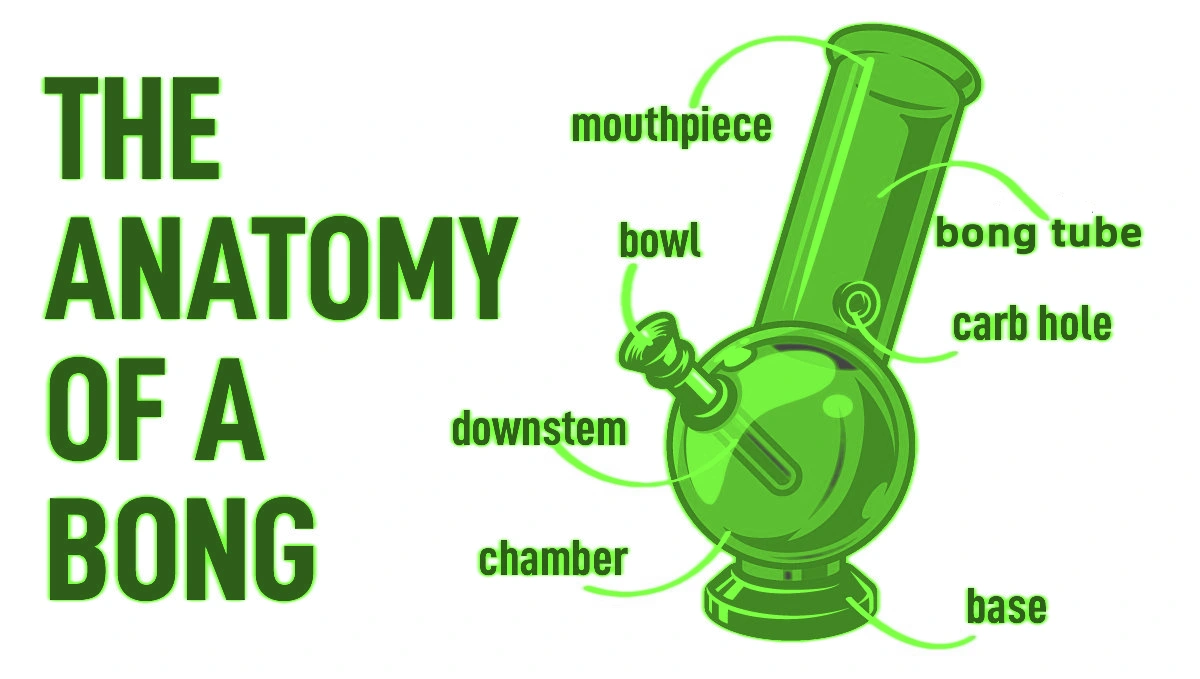Anatomy of a Bong: 12 Key Parts and Their Functions
Maybe you’ve used a bong but never thought much about its parts. Or maybe you’re just getting into them and want to learn more.
Whatever the case, knowing bong’s components can help you get smoother hits, keep it clean, and pick the perfect one for you.
In this guide, we’ll break down each essential part—no complicated terms, just clear and simple explanations.
What Is a Bong?
A bong, or water pipe, is a popular smoking device. It consists of four main components: a water chamber for filtration, a bowl to hold the cannabis, a downstem connecting the bowl to the water, and a mouthpiece for inhaling. As the smoke passes through the water, it cools and filters, resulting in a smoother and less harsh experience.
Are all parts of a bong the same?
Bongs come in a variety of shapes (such as beaker bong and straight tube styles), sizes, and materials (with glass being the most common, though silicone, plastic, and metal options are also available). However, their basic structure and function remain consistent.
The 6 Essential Parts of a Bong
Let’s start by talking about the six most important parts of a bong. Without these components, a bong simply won’t function properly—this applies to all bong designs. These parts work together to ensure effective smoke filtration.
1. Bong Bowls
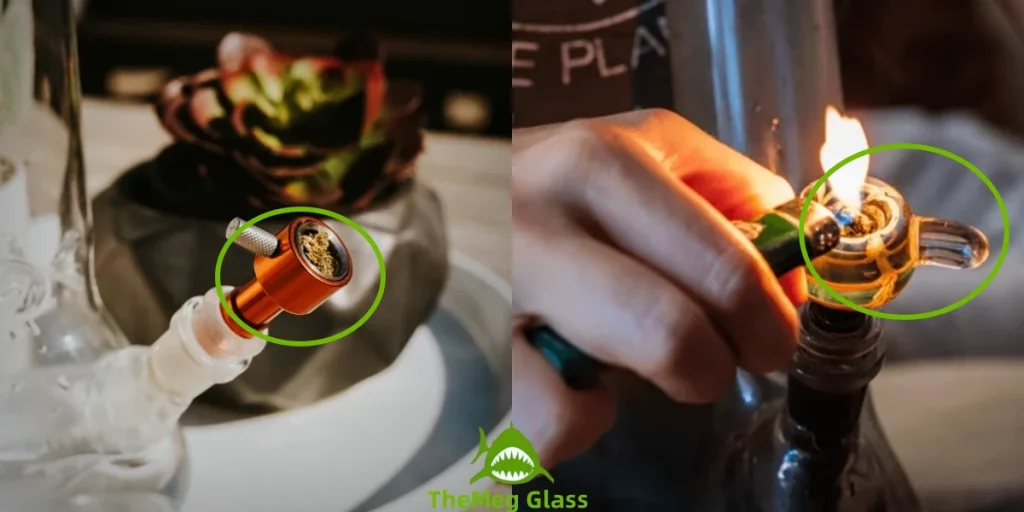
The bowl of a bong is where you place your cannabis, making it a key part of your smoking setup. It’s typically the first step in the process, where you pack your ground herbs. Once your herb is packed into the bowl, you can either place it in the downstem or insert it directly into the joint.
Bowls come in various shapes, sizes, and styles, but they all serve the same purpose—holding your dry herbs.
The most common bowl sizes are 10mm, 14mm, and 18mm, and bowls come with either male or female joints. A male-jointed bowl fits only into a female joint, and vice versa, so it’s important to match the right joint type for your bong.
Like water bongs, the most common material for bong bowls is glass, though durable metal and more visually appealing ceramic options are also available.
The size of the bowl affects the size of your hits—larger bowls deliver bigger hits, while smaller bowls are better for lighter tokes.
2. Downstem
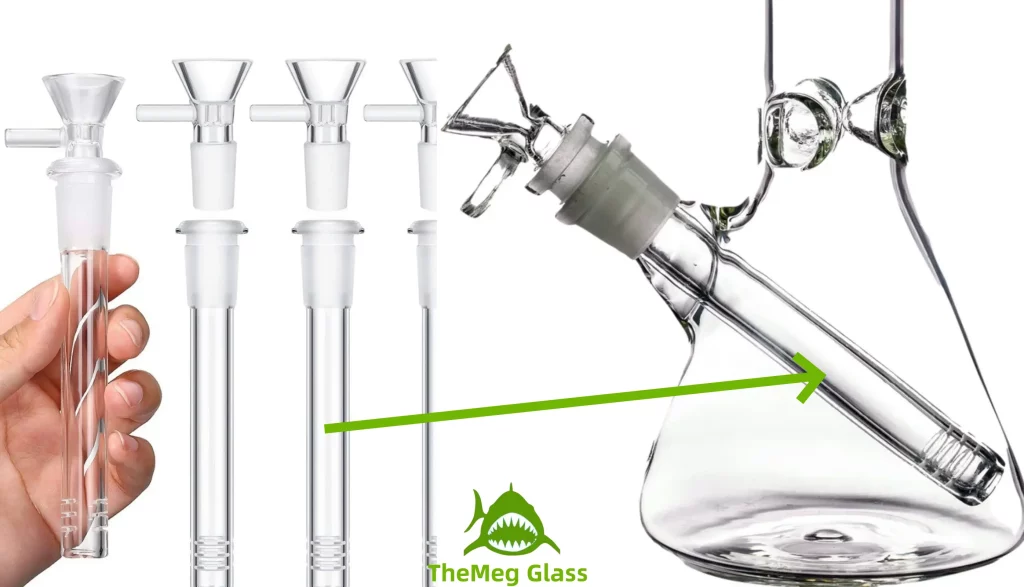
The downstem is essential to your bong setup, acting as the conduit that carries smoke from the bowl to the water chamber, where it is cooled and filtered for a smoother, more enjoyable hit.
To ensure a proper fit, your downstem should match your bong’s joint size. For example, a 18mm female joint requires a 18mm male downstem.
Most downstems are 3-5 inches long and made of glass, though durable metal and silicone options are also available. The bottom features precision-cut slits that create bubbles, cooling and filtering the smoke for a smoother inhale.The gurgling sound you hear when inhaling is caused by these bubbles.
3. Bong’s Joint
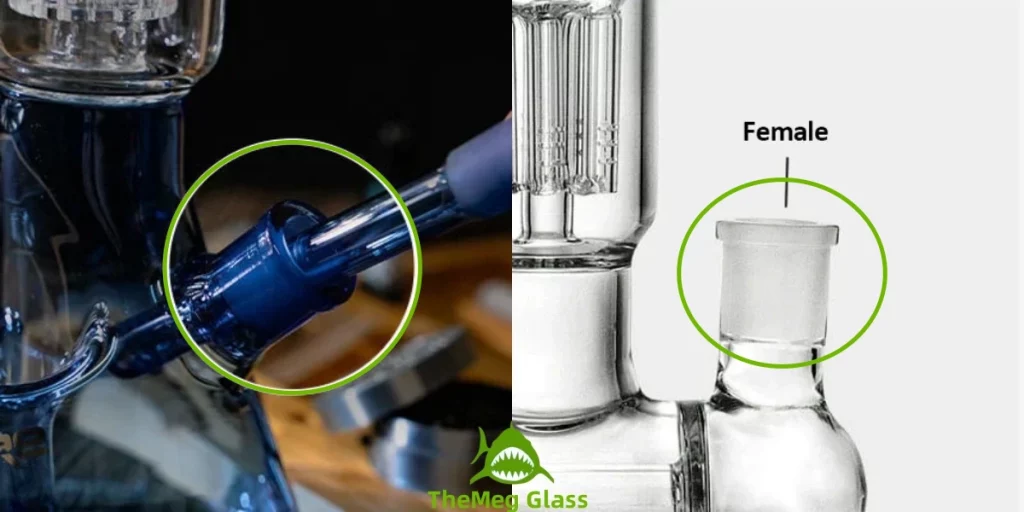
The joint is the part of the bong that connects the base to the downstem or bowl. While most bongs use a downstem, some designs allow the bowl to fit directly into the joint without one.
Joints come in male or female variations. A female joint accepts a male bowl or downstem, while a male joint accepts a female one.
Knowing your joint size is crucial for a proper fit, as the joint creates an airtight seal that ensures smooth airflow and efficient filtration. Glass joints, typically measured in millimeters, form a secure connection between the bowl and downstem, preventing airflow loss and optimizing performance. The most common sizes are 10mm, 14mm, and 18mm, with the 18mm female joint being the most popular on the market.
Some bongs feature fixed downstems, where the bowl fits directly into the joint.
4. Water Chamber
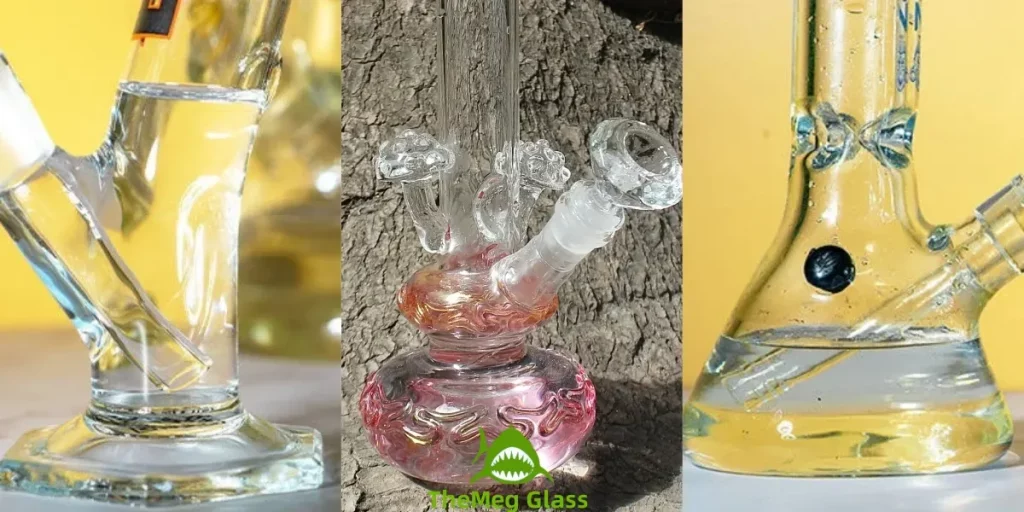
The water chamber, located at the base of the bong, is one of the most essential components in bong anatomy. It holds the water used to filter and cool the smoke, ensuring smoother hits. Many smokers enhance the cooling effect by adding ice cubes to this chamber.
The size and shape of the water chamber vary depending on the bong style. Beaker bongs feature a wide, conical base, while straight-based bongs have a smaller, single-cylinder chamber. Round-base bongs offer a flat bottom and a larger volume, leading to bigger hits. A larger water chamber, like that of a beaker bong, typically filters and cools the smoke more effectively than a narrow straight tube.
Maintaining the right water level is crucial. Too much water can cause splash-back, while too little affects filtration. It’s important to experiment with water levels to find your ideal balance and always change the water after each use to prevent mold buildup.
5. Bong Neck/Bong Tube
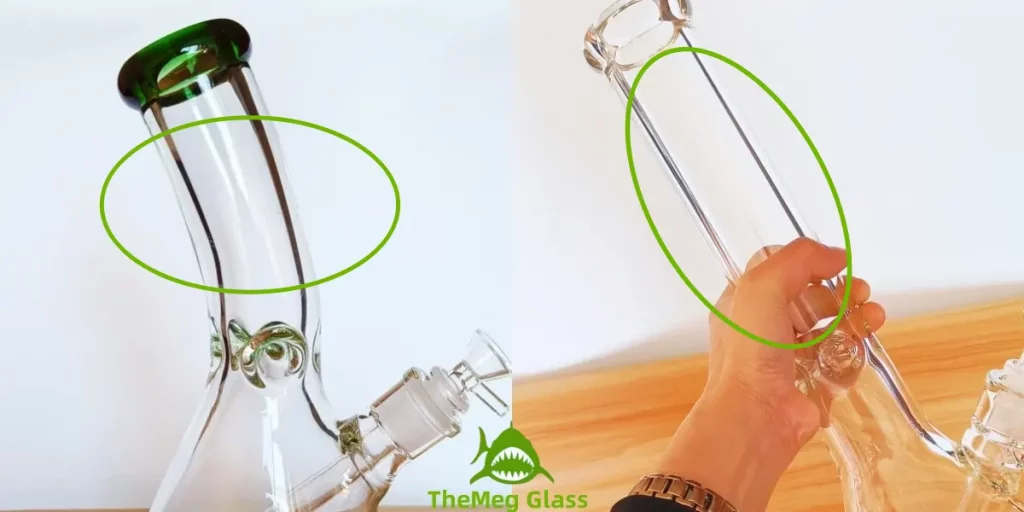
The bong neck is a crucial component that connects the water chamber to the mouthpiece, allowing filtered smoke to travel for inhalation.
Most bong necks are straight, though some may be bent or curved. Longer necks provide more cooling, as the smoke has a greater distance to travel before reaching the mouthpiece. Some bongs include additional cooling features in the neck, such as glycerin coils or ice pinches.
They are usually made from borosilicate glass, offering a clear view of the smoke as it rises, adding a visual element to the experience.
6. Mouthpieces
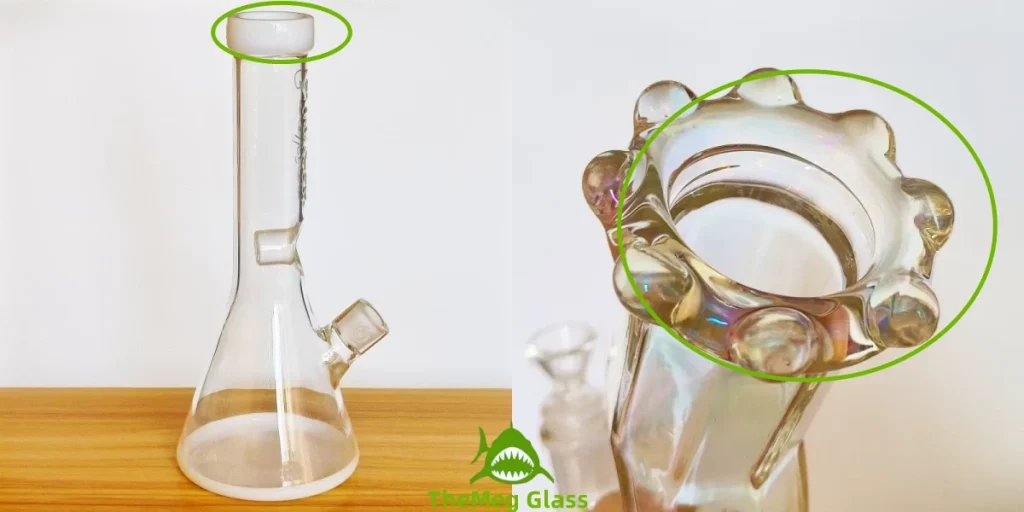
The mouthpiece is the final contact point for smoke before it enters your lungs. Located at the end of the bong tube or neck, it’s where you place your lips to inhale. While traditional bongs featured horizontal mouthpieces at the highest point, many modern designs now feature angled or bent necks, offering a more comfortable inhaling experience without the need to lean over.
Mouthpieces vary in shape and size—some offer a snug fit, while others have wider openings for larger hits. Choosing the right mouthpiece depends on your personal preference and desired smoking experience.
A good mouthpiece should be smooth, without scraping the lips or allowing smoke to leak. If you’ve ever used a low-quality bong, you may have noticed that the mouthpiece isn’t rounded enough, making the inhaling experience uncomfortable.
The 4 Additional Parts of a Bong
In addition to the 6 basic parts, some bongs come with extra parts to enhance the user experience or provide more customization options. These components are also quite common, so let’s explore them further.
7. Ash Catcher
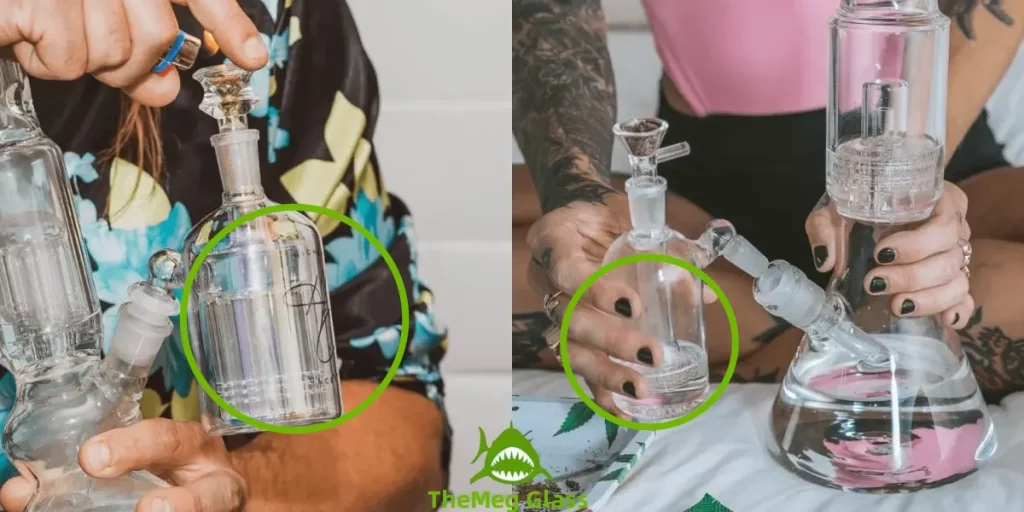
Ash Catcher, as the name suggests, its main function is to catch the ash that falls through the hole in your bowl. It connects to the downstem before adding the bowl or cone piece. This prevents ash from entering the bong, and potentially your mouth.
Ash catchers also trap most of the tar and residue from regular use before it reaches your bong.They are especially useful for frequent smokers, as cleaning an ash catcher is far simpler than cleaning a full bong.
While its primary purpose is to catch ash, many ash catchers come with built-in percolators for extra filtration and cooling of the smoke.
8. Percolators

The percolators , or “percs”, is used to filter the smoke additional times after it passes the water at the end of your stem. They divide the smoke into multiple paths, creating thousands of micro-bubbles. The result is a smoother, cleaner hit with less harshness, offering a more pleasant bong rip.
There are various types of percs, such as tree percs, honeycomb percs, and showerhead percs, each providing unique benefits for water diffusion, smoke filtration, and a gentler smoking experience. A percolator helps cool, moisturize, and filter the smoke, making for a smoother, cooler experience.
The main drawback of percolators is that they need regular cleaning to prevent clogging. For beginners, it’s best to avoid designs with many small holes, as these can be harder to clean. A UFO perc, for example, is a better option for easier maintenance.
9. Ice Pinches
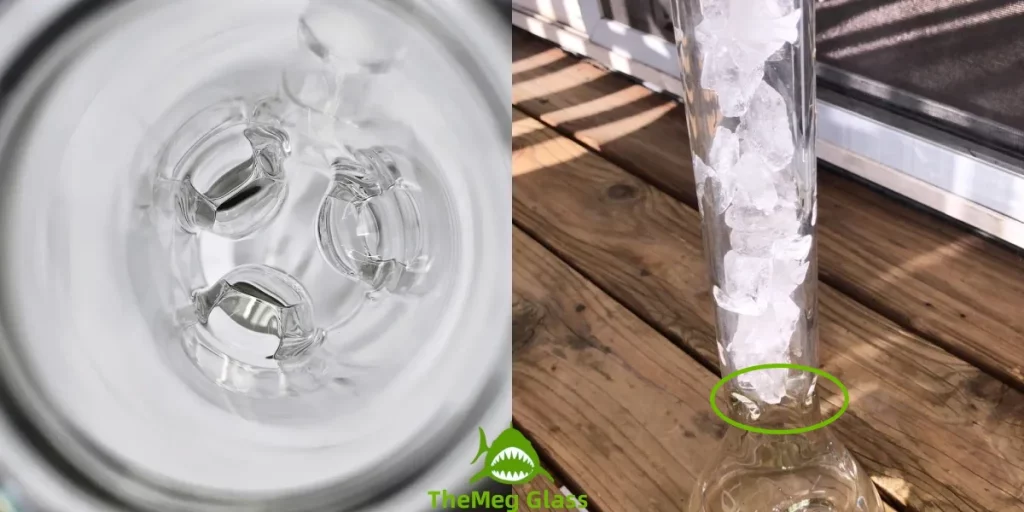
Ice pinches are small indentations or protrusions inside a bong’s neck, designed to hold ice cubes for cooling the smoke. As hot smoke passes over the ice, its temperature drops, resulting in less irritation to the lungs and a smoother, gentler hit. Bongs equipped with ice pinches are often referred to as “ice bongs.”
These pinches usually consist of three glass spikes that securely hold the ice, cooling the smoke before it reaches the mouthpiece.
10. Splash Guard
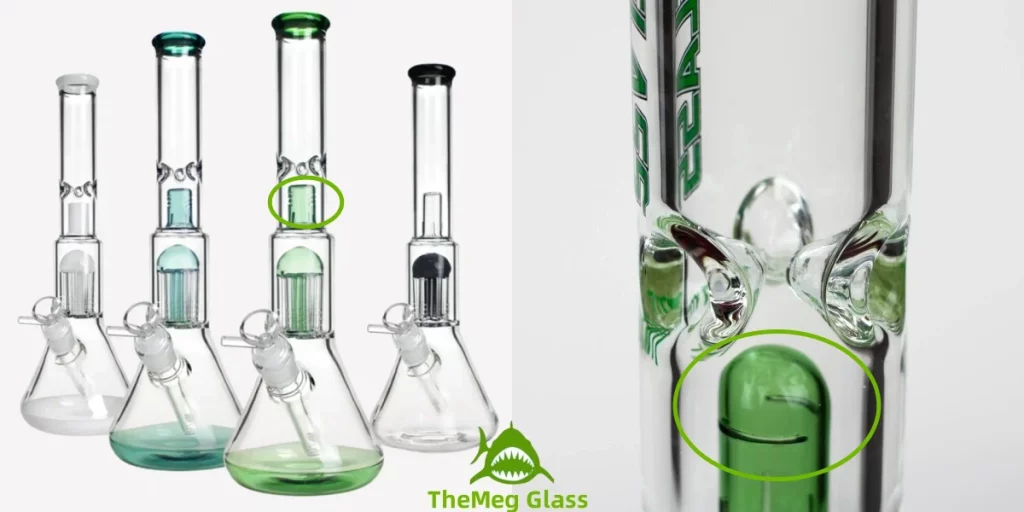
A splash guard is a simple yet crucial feature designed to block water from reaching your mouth during a hit. Positioned in the neck of the bong (just above the water chamber), it acts as a barrier—either through a dome shape, slotted design, or perforated disc—that catches and redirects splashes back into the base.
For Small Bongs (Micro Rigs): Since compact designs have less distance between the water and mouthpiece, splash guards are essential to avoid drinking bong water mid-hit.
For Heavy Percolation: Bongs with multiple percs (e.g., tree percs, matrix percs) create vigorous bubbling, increasing splash risk. A guard ensures smooth hits without watery interruptions.
Some bongs use a curved or bent neck instead of a built-in guard. The angle naturally traps rising water droplets, serving the same purpose. While not as precise as a dedicated splash guard, it’s an effective alternative in many designs.
11. Carburetor
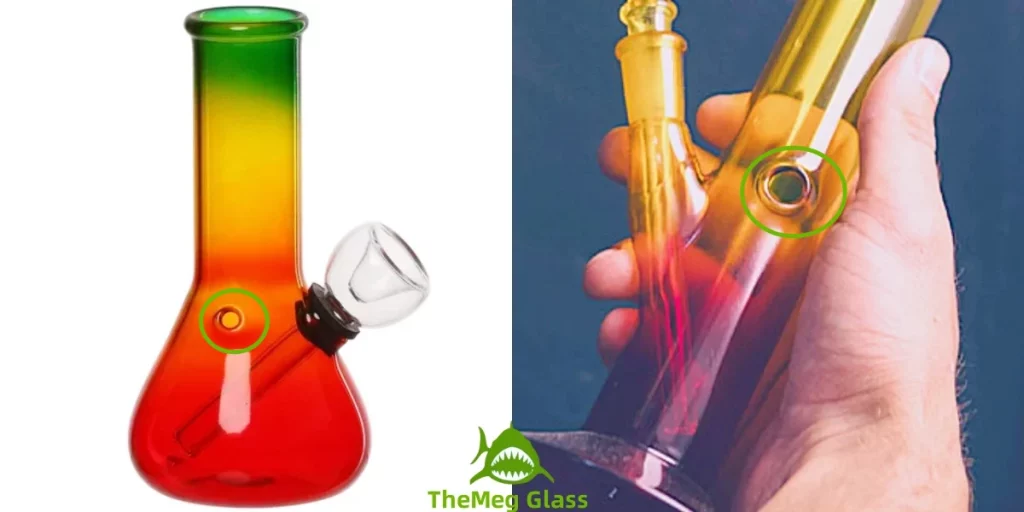
A carburetor, or carb hole, is a small hole on a bong or bubbler that controls airflow. It allows you to manage the air-to-smoke ratio, affecting how the herb burns and the intensity of your hits. Most bongs feature a pull-out bowl that functions like a carb, letting you clear the chamber by removing the bowl.
If there’s no removable bowl, the carb hole is typically located near the bowl or on the neck close to the mouthpiece. To use the carb, cover the hole with your finger while filling the chamber with smoke. Once full, release your finger to let in air and inhale, ensuring a smoother, more controlled hit.
12. Grommet
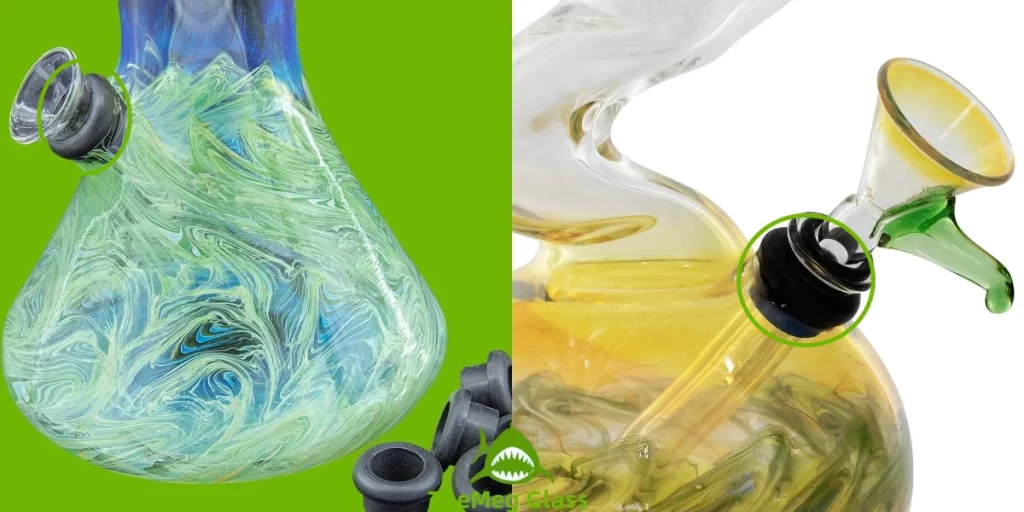
A grommet is a rubber seal around the joint where the bowl connects to the downstem, preventing air leaks in bongs. By sealing the bowl securely, it helps maintain the vacuum effect needed for smooth smoke draw.
While many glass bongs are custom-fitted to prevent air leaks and do not require a rubber grommet, a good-quality grommet ensures smooth bong hits and prevents stale smoke from lingering in the chamber. When selecting a bong, check the quality and fit of the grommet to ensure the male and female sizes match for optimal performance.
How to Choose the Right Bong for You
Choosing the right bong mainly depends on your personal preferences, understanding of key bong parts and their functions, and what you plan to use it for. Whether you need a bong for dry herbs and flowers or a dab rig for cannabis oil and concentrates, several factors come into play. Different bong designs and filtration systems significantly impact the smoking experience, so keep these key points in mind when making your selection:
- Price: Choose a bong that fits within your budget while ensuring quality and functionality.
- Size and Height: Taller bongs generally offer better cooling effects, while smaller bongs are more portable.
- Material: Glass bongs provide a clean, smooth smoking experience, while silicone bongs are more durable and great for on-the-go use.
- Style: From classic straight tubes to cute girly designs, cool designs, choose a style that fits your aesthetic and functional needs.
- Percolators (Percs): Bongs with various types of percolators (such as tree percs or honeycomb percs) offer extra filtration and cooling for smoother, more enjoyable hits.
By considering these factors, you’ll be able to select the bong that best suits your needs and enhances your smoking experience.
Get the Basics Right, Enjoy Every Hit
Understanding the different parts of a bong isn’t just about knowing how it fits together—it’s about getting the best experience every time you smoke. The little details, from percolators to bowl sizes, can make a huge difference in how smooth and enjoyable your hits are. Just like anything else, taking the time to learn the basics helps you make smarter choices. When you know what you’re looking for, you’re not just buying a bong—you’re investing in a better session, every time.
Ready to take your smoking experience to the next level? Check out TheMeg Glass for high-quality glass bongs at unbeatable prices. Whether you’re after a simple starter piece or a premium design with advanced filtration, we offer top-tier craftsmanship without the hefty price tag. Don’t settle for less—shop now and get the best value for your money!

